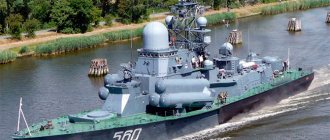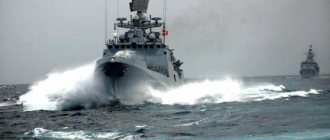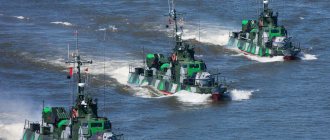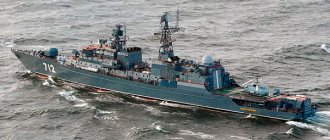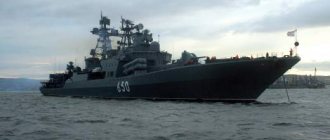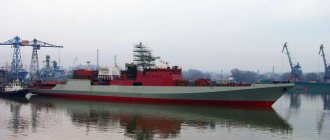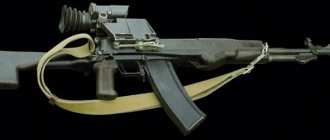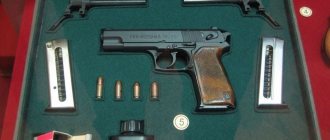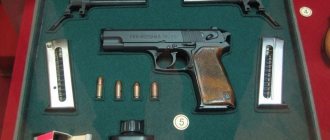Defensive arc
According to the vice-president of the Academy of Geopolitical Problems, Colonel Vladimir Anokhin, a strategic defensive arc is now being created in the Far East: Vladivostok - Kuril Islands - Sakhalin-Kamchatka.
“As expected, the defense is layered,” the expert told Izvestia. “On the distant approaches to the Russian coast, enemy ships, aircraft and landing craft will be met by the fleet with air support. Then - the new coastal missile systems "Bal" and "Bastion", the latter of which can destroy ships at a distance of up to 500 km. Directly on land, the enemy landing force will have to face the coastal forces of the Pacific Fleet. It is almost impossible to break through such a multilayer shield.
Kamchatka occupies a special position in this defensive configuration. An important part of the Northern Sea Route is controlled from its territory. We should not forget about the strategic submarine missile cruisers with nuclear weapons based on the peninsula.
Russia needs such an arc, since the situation in the region can hardly be called calm, recalled Vladimir Anokhin. According to him, Japan has not yet given up its dream of getting the Kuril Islands. And the United States has many military bases nearby, including in South Korea.
MRKs are well suited for use in inland seas and the coastal zone, says former Chief of the Main Staff of the Navy, Admiral Valentin Selivanov.
“They are needed in order to prevent foreign ships from approaching our naval bases,” he told Izvestia. — Foreign fleets have always had an interest in Kamchatka. In Vilyuchinsk there is a base of submarine missile cruisers with nuclear weapons, which the Gadflies will also have to cover. The submarines are part of Russia's strategic nuclear forces. RTOs will also participate in activities to ensure that these missile carriers go to sea.
"Gadfly" for pride: the Navy is modernizing small missile ships
The Navy has adopted a program for the return to service of small missile ships (SMRs) "Gadfly", Izvestia was told in the Main Command of the Navy. During the work, engines and radio electronics will be replaced on the MRK and modern weapons will be installed. Formally, RTOs are coastal ships, but previously they successfully sailed even to the Mediterranean and South China Seas. The updated and re-equipped Gadflies will be able to launch missile strikes against a potential enemy no worse than destroyers or frigates.
Complete renovation
The modernization of project 12341 "Gadfly" will affect almost all the key systems of the ship, explained the Main Command of the Navy. The MRK will be equipped with modern fire control equipment, radar stations, communication systems, more effective weapons, as well as more economical and powerful diesel engines.
“Gadflies” that have undergone modernization will be re-equipped with Kh-35 missiles - these are subsonic low-altitude ammunition with active homing, equipped with a high-explosive fragmentation warhead, a source in the Ministry of Defense told Izvestia. These missiles are capable of hitting targets at a distance of up to 260 km.
Izvestia Help
Currently, the Navy includes 12 small missile ships of Project 12341 “Gadfly”. In the Baltic Fleet, they are consolidated into the 36th brigade of missile boats, which includes the Zyb, Geyser, Passat and Liven MRKs. In the 41st brigade of the Black Sea Fleet - "Mirage" and "Shtil". In the Northern Fleet, the Iceberg and Rassvet are serving in the 7th Water District Security Brigade (OVR). In the Pacific Fleet, the Gadflies have been consolidated into the 114th OVR. “Tornado”, “Rime”, “Frost” and “Spill” are collected there. The existing ships entered the fleet from 1986 to 1992, with the exception of Shtil and Iceberg, which were built earlier - in the late 1970s.
Work on the modernization of Ovod has already begun. In April of this year, the repair of the main engine compartment of the Rassvet MRK was completed at the Kingisepp Machine-Building Plant. At the end of 2022, the Iceberg and Geyser engines were put in order there. The Smerch missile launcher is currently being repaired in Kamchatka. The Zyb MRK of the Baltic Fleet, which has been slow for a long time, is awaiting a major overhaul of the main engine at the 33rd shipyard.
"Buyans" of the South Sea: The Black Sea Fleet will be reinforced with missile ships
They are armed with Kalibr cruise missiles and Onyx supersonic missiles.
Efficient inside
The modernized Gadflies will seriously increase the combat effectiveness of the fleet, says former Chief of the Main Staff of the Navy, Admiral Valentin Selivanov.
“MRKs are good for use in inland seas and coastal zones,” Valentin Selivanov told Izvestia. — The USSR at one time kept “Gadflies” in the Mediterranean Sea - in Tartus and Tobruk. The task of such ships is to operate from an ambush. If danger arose, they had to disperse and wait for the command to launch an attack, or immediately jump out from the base and strike targets with missiles. The emergence of modern and effective missile weapons will only strengthen the evil and effective Gadflies. A short-range strike from such ships will be guaranteed to be accurate. After modernization, the ships will be able to serve for another ten years.
In the 1980s, the Gadflies, located in the eastern Mediterranean, were a headache for the US Sixth Fleet, which was responsible for that theater of operations. Tracking the movements of RTOs in the coastal theater of operations is a difficult matter. Their unpredictable actions caused serious concern among American admirals.
Technically, the return of the Gadflies to the Mediterranean became possible after the signing of an agreement with Syria on a long-term lease of the port of Tartus, Admiral Selivanov noted.
Armed and very comfortable: the Russian Navy received a digital missile carrier
Izvestia was the first to visit one of the most closed ships in the fleet
Small rocket ships of Project 12341 were created in the 1960s. Shipbuilders had to give the fleet inexpensive, compact, but at the same time fast ships. The order for the development was received by the Almaz Central Marine Design Bureau from Leningrad. The project was given the code “Gadfly”. In the navy, its name quickly became a colloquial designation for all ships of this project - it perfectly characterized the small but “biting” MRK.
In the hull of a ship with a displacement of about 700 tons, it was possible to place a full-fledged set of weapons. "Gadflies" with a length of 57 m and a width of 12 m received two launchers for six Malachite anti-ship missiles, a Titanit radar target designation system, electronic warfare equipment, an Osa-M anti-aircraft missile system and one AK-176 caliber artillery mount 76 mm, or two AK-725 with a caliber of 57 mm. And some modifications were equipped with AK-630M mounts with a caliber of 30 mm. The ship received three diesel engines, each with a power of 1000 l/s, which allowed it to reach speeds of up to 35 knots per hour.
Initially, they wanted to classify the MRK as a boat, but the Commander-in-Chief of the Navy, Admiral of the USSR Fleet Sergei Gorshkov, specifically approved a new class for it - a small rocket ship. When the first “Gadfly” was launched into the water, the commander-in-chief said a phrase that became famous: “These MRKs are a pistol at the temple of imperialism.” In NATO countries, "Gadflies" were "assigned" to corvettes.
Twice as powerful
"Gadflies" are still considered ships that are capable of effectively fighting warships and support vessels in the near ocean zone. Russian “Gadflies” received a baptism of fire during the war with Tbilisi. On August 10, 2008, the Mirage MRK sank a Georgian Navy fast boat.
Shoot out of the light: ships will receive new anti-aircraft missiles
They will help keep enemy aircraft at a distance
It’s too early to put “Gadflies” to the test. Sailors have always loved this ship for its firepower and reliability, says military expert Dmitry Boltenkov.
“For the Algerian Navy, three such small missiles were modernized at Russian shipyards,” Dmitry Boltenkov told Izvestia. “They received updated electronics and engines, and were also re-equipped with X-35 anti-ship missiles. This experience will be useful in the future. After modernization, domestic Gadflies can receive four launchers, each of which is capable of firing four missiles at once. This increased the ship's salvo from six to 16 rounds of ammunition. A salvo of 32 missiles from two ships will be approximately equal in power to a division of the Bal coastal missile system. As a result of modernization, the combat power of the Gadflies will increase by approximately two and a half times.
Theoretically, Onyx anti-ship missiles can be installed on the MRK. In 1982, one Gadfly of Project 1234.7 was developed and built to test these missiles. A total of 47 Gadflies of all projects were built, including export modifications. The ships were not only in service with the Russian Navy; they were purchased by Algeria, Libya and India.
design features of the MRK project 1234 code "Gadfly"
In terms of architecture, the smooth-deck hull of the Project 1234 warship has boat-like lines, is not very sheer, and is made of high-strength naval steel. RTOs have very good maneuverability associated with agility and quick stopping. MRK project 1234
MRK project 1234-1
For electronic warfare purposes, RTOs are equipped with two or four launchers for passive jamming, which are a package with sixteen guide tubes with cantilever mounts on the trunnion and vertical wall. False radar targets can be placed at a distance from the ship up to 3.5 km. The Titanit integrated radio system provides active and passive target detection, reception of information from aviation air surveillance and direction finding systems, and also ensures the generation and issuance of target designations to the command control post, management of joint combat operations and provides the solution of navigation problems. Navigation radar station "Don" and electronic reconnaissance station "Zaliv". The infrared equipment "Khmel-2" allows for joint navigation and covert communication in the dark, with the ships completely darkened, as well as observing and taking bearings of infrared lights.
Small missile ships of project 1234E (Ovod-E) and 1234EM
The export version of the Gadfly differed from the basic Project 1234 in the composition of its weapons - instead of 6x Malachite anti-ship missile launchers, they had 4x P-15M Termit anti-ship missiles.
In April 1977, the Uragan MRK (Serial number S-65, not to be confused with the Soviet Navy MRK of the same name with the number S-73) entered service for the Indian Navy, where it was classified as the K71 Vijay Durg corvette. It was originally built for the USSR Navy, but was converted according to project 1234E. On September 30, 2002, the ship was scrapped.
In September 1977, the Priboy MRK (serial number S-66, not to be confused with the Soviet Navy MRK of the same name with the number S-74) entered service for the Indian Navy, where it was classified as the K72 Sindhu Durg corvette. It was originally built for the USSR Navy, but was converted according to project 1234E. On September 24, 2003, the ship was scrapped.
In April 1978, the Priliv MRK (serial number S-67, not to be confused with the Soviet Navy MRK of the same name with the number S-75) entered service for the Indian Navy, where it was classified as the K73 Hos Durg corvette. It was originally built for the USSR Navy, but was converted according to project 1234E. On June 5, 1999, the ship was scrapped.
On February 22, 1978, the MRK-21 built for Algeria (serial number S-201e) was sold; in the Algerian Navy it bore the name Rais Hamidou (No. 801).
On May 21, 1981, the MRK-23 built for Algeria (serial number S-202e) was sold; in the Algerian Navy it bore the name “Salah Reis” (No. 802). In 1999-2000 the ship was upgraded to the 1234EM level and received completely updated equipment and weapons. The main striking force of the ship was 4 launchers with 16 Uran-E anti-ship missiles. A six-barreled 30-mm AK-630M artillery mount was installed in the aft part of the superstructure. On the roof of the cabin, instead of a "Rangout" type radar, an antenna of the "Garpun-E" radar complex was installed, as a result of which the appearance of this RTO has undergone significant changes.
On February 8, 1982, the MRK-22 built for Algeria (serial number S-204e) was sold; in the Algerian Navy it bore the name Rais AN (No. 803). In May 1997, the ship underwent repairs in Kronstadt.
On May 1, 1982, “MRK-9” (serial number S-203) was transferred to Libya; in the Algerian Navy it was named “Ein Mara”. On March 25, 1986, in the port of Tripoli, it was damaged by American aircraft and towed to Leningrad for repairs. In 1991, after repairs, she was renamed Tariq ibn Ziyad and again included in the fleet. Airborne number 416.
On January 19, 1983, the MRK-24 (serial number S-205) was transferred to Libya; in the Algerian Navy it was listed as a missile corvette and bore the name Ein al Ghazala. Airborne number 417.
On March 15, 1984, the “MRK-25” (serial number S-206) was transferred to Libya; in the Algerian Navy it was listed as a missile corvette and bore the name “Ein Zara”. Airborne number 418.
In September 1985, the MRK-15 (serial number S-207) was transferred to Libya; in the Algerian Navy it was listed as a missile corvette and bore the name Ein Zakit. Airborne number 419. On March 25, 1986, she was sunk by American aircraft 20 miles west of the port of Benghazi.
• Directory of the Navy • Ships of the same period • Russian Navy •
Small rocket ships.
Project 1234 ships (“Nanuchka-I class” according to NATO classification) are designed to protect sea communications, guard convoys, and combat surface ships in coastal areas. The ship's power plant consists of three diesel engines with a total power of 30,000 hp, which rotate three propellers. The maximum speed is 34 knots.
The first two small missile ships of Project 1234 were in service until April 25, 1970. only digital tactical name: lead "MRK-3", first production hull - "MRK-7". Subsequent ships were assigned “weather” names, traditional for Soviet patrol ships of the Great Patriotic War, and for their “weather” names they were called the “bad weather division.” The lead ship of the "Storm" project.
Photos of the ships were taken from the site www.forums.airbase.ru
……………………………………………………………………………………………………………………………………………………………………………
Small rocket ship Burya.
Small rocket ship MRK-3 - built within the framework of Project 1234, code "Gadfly". Launched October 18, 1968, April 25, 1970. renamed "Storm". Entered service on September 30, 1970, and already on February 9, 1971. became part of the Red Banner Black Sea Fleet (KChF). July 5, 1971 The management of the 166th Novorossiysk Red Banner Division of small missile ships was formed, and on August 14, 1971. small missile ships MRK "Burya" and "Breeze" are subordinate to the commander of the 166th DNMRK. March 11, 1980 The 295th Sulino Red Banner division of torpedo boats was disbanded and on its basis the 295th Sulino Red Banner division of small missile ships was created, consisting of:
MRK "Storm";
MRK "Groza";
MRK-5;
PD-26;
PD-19.
By order of the Navy Civil Code dated December 24, 1976. The Zarnitsa and Burya MRKs were declared the best tactical group of MRKs based on the results of an inspection by the USSR Ministry of Defense.
04/15 to 06/16/1982 Together with the Grom MRK and PRTB-33 - BS in the Mediterranean Sea.
01 August 1986 transferred to the Red Banner Pacific Fleet (KTOF)
Board numbers: 540, 354, 961, 964(1977), 604(1978), 601, 603, 602(1982), 609(1984), 605(1986), 608(1990), 624(1.05.1990). Decommissioned: 1991
……………………………………………………………………………………………………………………………………………………………………………
Small rocket ship Breeze.
Small rocket ship MRK-7 - built within the framework of Project 1234, code "Gadfly". Launched October 10, 1969, April 25, 1970. renamed "Breeze". Entered service on December 31, 1970, and already on February 9, 1971. became part of the Red Banner Black Sea Fleet (KChF). Since December 1970 testing of the Malachite rocket launcher began - the first launch took place on December 29, 1970.
July 5, 1971 The management of the 166th Novorossiysk Red Banner Division of small missile ships was formed, and on August 14, 1971. small missile ships MRK "Burya" and "Breeze" are subordinate to the commander of the 166th DNMRK.
October 30, 1973 Together with the Groza MRK, PRTB-13 (KUG) - BS in the Mediterranean Sea. While on duty, in October, the exercise “Conducting a missile strike by a TG MRK on an AUG from a tracking position based on data from its own assets” was conducted.
From 01.11 to 17.11.1974 Together with the Vikhr MRK and PRTB-33 (KUG) - BS in the Mediterranean Sea. When carrying out tasks, we carried out weapons tracking of the Littell Rock missile launcher and conducted a missile strike exercise against the Forrestal missile launcher and the Long Beach missile launcher.
From 25.06 to 01.08.1977 Together with the Zarnitsa MRK and PRTB-13 (KUG) - BS in the Mediterranean Sea. When carrying out tasks, we carried out weapon tracking of the Long Beach missile launcher for the US Navy integrated supply ship.
From 17.06 to 08.08.1978 Together with the Grom MRK and PRTB-33 (KUG) - BS in the Mediterranean Sea. We carried out the task of tracking the Kitty Hawk AVU with weapons. On June 22-27, the MRK "Briz" as part of the group of ships of the RKR "Admiral Golovko", the BOD "Ochakov" made an official visit to the port of Latakia, SAR.
From July 23 to September 3, 1979 Together with the Grom MRK and PRTB-33 (KUG) - BS in the Mediterranean Sea. During combat service, they carried out long-term tracking with the weapons of the AUG AVU "Forrestal" CR URO "Yarnel", FR URO "Kelsh".
From September 19 to October 20, 1980 Together with the Zyb MRK and PRTB - BS in the Mediterranean Sea. During the exercise “Destruction of an AUG by forces of 5 OPESK in cooperation with the MRA of the fleet,” they carried out weapons tracking of the AUG AVU “America”, the CR URO “Little Rock”, the FR URO “Vodzh”, a comprehensive supply ship of the US Navy, with the subsequent delivery of a simulated missile strike .
From August 15 to September 2, 1981 went to the BS for reinforcement (the BS MRK "Zyb", MRK "Zarnitsa" and PRTB-13 were already carried on site) due to the aggravated situation in Lebanon on August 15. The ships carried out weapons tracking of the AUG AVU "Enterprise" of the CRA URO "Long Beach" followed by the TDK "Guadalcanal" south of the island of Cyprus.
In 1981 The tactical group consisting of the Briz and Zarnitsa missile launchers was declared the best in missile training in shooting at sea targets and received a challenge prize from the USSR Navy.
From 25.05 to 05.08.1983 Together with the MRK "Komsomolets of Mordovia" MRK "Zarnitsa" and PRTB-33 (KUG) - BS in the Mediterranean Sea.
from November 20, 1983 to 02/20/1984 Together with the MRK "Komsomolets of Mordovia" and PRTB-33 they carried BS in the Mediterranean Sea.
01 August 1986 transferred to the Red Banner Pacific Fleet (KTOF).
From 05/10/1987 to 05/20/1988 joined the BS in Cam Ranh.
Board numbers: 356, 966, 962(1977), 963, 967, 611, 602(1980), 623, 617(1982), 606(1984), 612(1984), 618(1986), 403(05.1987), 430(05.1990). Decommissioned: 1992 .
……………………………………………………………………………………………………………………………………………………………………………
Small rocket ship Vikhr.
Small rocket ship Vikhr - built within the framework of Project 1234, code "Gadfly". Launched on July 22, 1970, and entered service on September 30, 1971, and already on November 1, 1971. became part of the Red Banner Black Sea Fleet (KChF).
From 01.11 to 17.11.1974 Together with the Briz MRK and PRTB-33 - BS in the Mediterranean Sea. When carrying out tasks, we carried out weapons tracking of the Littell Rock missile launcher and conducted a missile strike exercise against the Forrestal missile launcher and the Long Beach missile launcher.
08/01/1977 transferred to the Red Banner Pacific Fleet (KTOF).
07/26/1992 changed the USSR Naval flag to St. Andrew's.
Board numbers: 978(1975), 351(1976), 955, 966, 425(1985), 438(05.1990), 432(1994).
Decommissioned: 1994
……………………………………………………………………………………………………………………………………………………………………………
Small rocket ship Grad.
Small rocket ship Grad - built within the framework of Project 1234, code "Gadfly". Launched on April 30, 1972, and entered service on September 30, 1972, and already on October 31, 1972, became part of the Twice Red Banner Baltic Fleet (DKBF). In 1983, 1985 and 1987 won the prize of the Navy Civil Code for missile training (as part of the KUG).
26.7.1992 changed the USSR Naval flag to St. Andrew's
Board numbers: 941(1973), 506, 567, 552(1987), 582(1990). Decommissioned: 1993
……………………………………………………………………………………………………………………………………………………………………………
Small rocket ship Grom.
Small rocket ship Grom - built within the framework of Project 1234, code "Gadfly". Launched on October 29, 1972, and entered service on December 28, 1972, and already on January 31, 1973. became part of the Twice Red Banner Baltic Fleet (DKBF). September 4, 1973 transferred to the Red Banner Black Sea Fleet (KChF). In 1978 and 1992 won the prize of the Navy Civil Code for missile training (as part of the KUG).
From 3.06 to 8.09.1975 Together with the Zarnitsa MRK and PRTB-33 (KUG) BS in the Mediterranean Sea. On July 11, the KUG was given the task of carrying out reconnaissance, tracking and launching a conditional missile strike on the Forrestal missile launcher, passing the meridian 22 degrees. The problem was successfully solved on July 12.
From 17.06 to 8.08.1978 Together with the Briz MRK and PRTB-33 (KUG) BS in the Mediterranean Sea. We carried out the task of tracking the Kitty Hawk with weapons.
From July 23 to September 3, 1979 Together with the Briz MRK and PRTB-33 - BS in the Mediterranean Sea. During combat service, they carried out long-term tracking with the weapons of the AUG AVU "Forrestal" CR URO "Yarnel", FR URO "Kelsh".
04/15 to 06/16/1982 Together with the Burya MRK and PRTB-33 (KUG) BS in the Mediterranean Sea.
26.7.1992 changed the USSR Naval flag to St. Andrew's.
Board numbers: 361(1976), 976(1977), 818(1979), 608, 604(1982), 605(1984), 607(1986), 622(1.05.1990). Decommissioned: 1995
……………………………………………………………………………………………………………………………………………………………………………
Small rocket ship Groza.
Small rocket ship Groza - built within the framework of Project 1234, code "Gadfly". Launched on July 26, 1972, and entered service on December 28, 1972, and already on January 31, 1973. became part of the Twice Red Banner Baltic Fleet (DKBF). September 4, 1973 transferred to the Red Banner Black Sea Fleet (KChF). On March 11, 1980, the 295th Sulino Red Banner Division of torpedo boats was disbanded and on its basis the 295th Sulina Red Banner Division of small missile ships was created, consisting of:
MRK "Storm";
MRK "Groza";
MRK-5;
PD-26;
PD-19.
October 30, 1973 Together with the Briz MRK and PRTB-13 (KUG) - BS in the Mediterranean Sea. While on duty, in October, the exercise “Conducting a missile strike by a TG MRK on an AUG from a tracking position based on data from its own assets” was conducted.
From 2.06 to 12.07.1976 Together with the Zarnitsa MRK and PRTB-13 - BS in the Mediterranean Sea. From June 19, we carried out weapons tracking of the AVU "America". KR URO "Yarnel", FR "Voj". Participation in the exercises "Crimea-76".
Board numbers: 363, 358, 977(1973), 970, 611, 604(1980), 613(1982), 614(1984), 604(1986), 619(1.05.1990). Decommissioned: 1992
……………………………………………………………………………………………………………………………………………………………………………
Small rocket ship Zarnitsa.
Small rocket ship Zarnitsa - built within the framework of Project 1234, code "Gadfly". Launched on April 28, 1973, and entered service on September 18, 1973, and already on October 26, 1973. became part of the Red Banner Black Sea Fleet (KChF). In 1978, 1981, 1984, 1988, 1993, 1994 and 1998 won the prize of the Navy Civil Code for missile training (as part of the KUG).
From 3.06 to 8.09.1975 Together with the Grom MRK and PRTB-33 (KUG) BS in the Mediterranean Sea. On July 11, the KUG was given the task of carrying out reconnaissance, tracking and launching a conditional missile strike on the Forrestal missile launcher, passing the meridian 22 degrees. The problem was successfully solved on July 12.
From 2.06 to 12.07.1976 Together with the Groza MRK and PRTB-13 - BS in the Mediterranean Sea. From June 19, we carried out weapons tracking of the AVU "America". KR URO "Yarnel", FR "Voj". Participation in the exercises "Crimea-76".
By order of the Navy Civil Code dated December 24, 1976, the Zarnitsa and Burya MRKs were declared the best tactical group of MRKs based on the results of an inspection by the USSR Ministry of Defense.
From 25.06 to 01.08.1977 Together with the Briz MRK and PRTB-13 (KUG) - BS in the Mediterranean Sea. When carrying out tasks, we carried out weapon tracking of the Long Beach missile launcher for the US Navy integrated supply ship.
From July 15 to September 2, 1981 Together with the Zyb MRK and PRTB-13 - BS in the Mediterranean Sea. The ships carried out weapons tracking of the AUG AVU "Enterprise" of the CRA URO "Long Beach" followed by the TDK "Guadalcanal" south of the island of Cyprus.
In 1981 The tactical group consisting of the Briz and Zarnitsa missile launchers was declared the best in missile training in shooting at sea targets and received a challenge prize from the USSR Navy.
In 1984 a tactical group consisting of the Zarnitsa MRK and the Komsomolets Mordovia MRK received the challenge prize of the Navy Civil Code for missile firing at the MC.
From May 15 to June 15, 1984 Together with Komsomolets Mordovia - BS in the Mediterranean Sea. In the period from May 27 to May 29, the MRK TG as part of KUG-2 took part in the operational-tactical exercise 5 OPEC "Destruction of enemy AMG OS RUS in cooperation with the fleet MRA"
09/24/93 — a tactical group consisting of the Zarnitsa MRK and the Mirage MRK received the challenge prize of the Navy Civil Code for missile firing at the MC.
09/22/94 a tactical group consisting of the Zarnitsa MRK and the Shtil MRK received the challenge prize of the Navy Civil Code for missile firing at the MC.
06/12/1997 changed the USSR Naval flag to St. Andrew's.
Board numbers: 363(1976), 973, 972, 607, 618, 606(1990), 621(1.05.1990). Decommissioned: 2005
……………………………………………………………………………………………………………………………………………………………………………
Small rocket ship Shkval.
Small rocket ship Shkval - built within the framework of Project 1234, code "Gadfly". Launched on December 28, 1973, and entered service on June 14, 1974, and already on July 16, 1974. became part of the Twice Red Banner Baltic Fleet (DKBF) as part of the 106th MRK division of the 76th BEV, based at the Winter Harbor of the Liepaja naval base. After 1992 The division was transferred to the 36th Missile Boat Brigade of the 12th Surface Ship Division.
07/26/1992 changed the USSR Naval flag to St. Andrew's.
Board numbers: 915 (1976), 551 (1985), 567, 565. Decommissioned: 1994.
……………………………………………………………………………………………………………………………………………………………………………
Small rocket ship Metel.
Small rocket ship Metel - built within the framework of Project 1234, code "Gadfly". Launched on August 10, 1974, and entered service on December 8, 1974, and already on January 23, 1975. became part of the Red Banner Northern Fleet (KSF). In 1982 won the prize of the Navy Civil Code for missile training (as part of the KUG).
07/26/1992 changed the USSR Naval flag to St. Andrew's
Board numbers: 923 (1977), 534 (1979), 542. Decommissioned: 1998.
……………………………………………………………………………………………………………………………………………………………………………
Small rocket ship Storm.
Small rocket ship Storm - built within the framework of Project 1234, code "Gadfly". Launched on March 3, 1975, and entered service on June 15, 1975, and already on July 21, 1975. became part of the Twice Red Banner Baltic Fleet (DKBF). In 1983, 1985 and 1987 won the prize of the Navy Civil Code for missile training (as part of the KUG).
07/26/1992 changed the USSR Naval flag to St. Andrew's
Board numbers: 953, 587(1978), 567, 577(1990). Decommissioned: 1998
……………………………………………………………………………………………………………………………………………………………………………
Small rocket ship Cyclone.
Small rocket ship Cyclone - built within the framework of Project 1234, code "Gadfly". Launched on May 24, 1977, and entered service on December 31, 1977, and already on February 17, 1978. became part of the Red Banner Pacific Fleet (KTOF).
Since May 1985 to May 1986 Together with the Typhoon MRK - BS to Vietnam, South China Sea, Cam Ranh Bay.
07/26/1992 changed the USSR Naval flag to St. Andrew's.
Board numbers: 430, 438, 425(1984), 435(1985), 412(05.1987), 444(05.1990). Decommissioned: 1995
……………………………………………………………………………………………………………………………………………………………………………
Small rocket ship Monsoon.
Small rocket ship Monsoon - built within the framework of Project 1234, code "Gadfly". Launched on July 1, 1981, and entered service on December 30, 1981, and already on February 9, 1982. became part of the Red Banner Pacific Fleet (KTOF - 165 BrRKA Pacific Fleet). April 16, 1987 died in the Sea of Japan due to spontaneous retargeting of a missile while practicing combat training tasks.
Board numbers: 427(1982), 414(1984).
……………………………………………………………………………………………………………………………………………………………………………
The logical continuation of this series of small missile ships was Project 1234.1 (“Nanuchka-III class” according to NATO classification). The main differences of this project are the increase in the main caliber of artillery from 57 mm to 76 mm, the additional installation of one 30 mm AK-630 artillery complex on the ship, as well as new radar and electronic equipment. Despite the relatively small displacement, the ship of this project has high seaworthiness and the ability to use weapons in a sea state of 5 points and a speed of 24 knots.
……………………………………………………………………………………………………………………………………………………………………………
Small rocket ship Burun.
Small rocket ship Burun - built within the framework of project 1234.1, code "Gadfly-1". Launched in July 1977, and entered service on December 30, 1977, and already on February 17, 1978. became part of the Red Banner Northern Fleet (KSF). April 21, 1978 listed in the DKBF.
In 1978 he won the prize of the Navy Civil Code for missile training (as part of the KUG).
07/26/1992 changed the USSR Naval flag to St. Andrew's.
Board numbers: 570, 559(1986), 566(1990). Decommissioned: 2002
……………………………………………………………………………………………………………………………………………………………………………
Small rocket ship Veter.
Small rocket ship Veter - built within the framework of project 1234.1, code "Gadfly-1". Launched on April 21, 1978, and entered service on September 30, 1978, and already on November 23, 1978. became part of the Red Banner Northern Fleet (KSF). In 1980 won the prize of the Navy Civil Code for missile training (as part of the KUG).
07/26/1992 changed the USSR Naval flag to St. Andrew's.
Board numbers: 572(1978), 527, 523, 524(1995). Decommissioned: 1995
……………………………………………………………………………………………………………………………………………………………………………
Small rocket ship Zyb.
Small rocket ship Zyb - built within the framework of project 1234.1, code "Gadfly-1". Launched on October 23, 1978, and entered service on December 31, 1978, and already on February 16, 1979. became part of the Red Banner Black Sea Fleet (KChF). On April 13, 1982 it was renamed “Komsomolets of Mordovia”, and on February 15, 1992. in "Calm".
From September 19 to October 20, 1980 Together with the Briz MRK and PRTB-13 (KUG) - BS in the Mediterranean Sea. During the exercise “Destruction of an AUG by the forces of 5 OPESK in cooperation with the Fleet MRA”, weapons were used to track the AUG AVU “America”, the CR URO “Little Rock”, the FR URO “Vodzh”, a comprehensive supply ship of the US Navy, followed by a simulated missile strike. .
From 15.07 to 02.09.1981 Together with the Zarnitsa MRK and PRTB-13 - BS in the Mediterranean Sea. The ships carried out weapons tracking of the AUG AVU "Enterprise" of the CRA URO "Long Beach" followed by the TDK "Guadalcanal" south of the island of Cyprus.
From May 25 to August 5, 1983 Together with the Briz MRK, the Zarnitsa MRK and PRTB-33 (KUG) - BS in the Mediterranean Sea.
From November 20, 1983 to February 20, 1984 Together with the Briz MRK and PRTB-33 (KUG) - BS in the Mediterranean Sea.
From May 15 to June 15, 1984 Together with the Zarnitsa MRK and PRTB-33 - BS in the Mediterranean Sea. In the period from May 27 to May 29, the MRK TG as part of KUG-2 took part in the operational-tactical exercise 5 OPEC "Destruction of enemy AMG OS RUS in cooperation with the fleet MRA"
In 1984, 1989, 1990, 1991, 1993 and 1998 won the prize of the Navy Civil Code for missile training (as part of the KUG).
06/12/1997 changed the USSR Naval flag to St. Andrew's.
Currently, the small missile ship "Shtil" of project 1234.1 is part of the 166th Novorossiysk Red Banner small missile ships of the 41st brigade of missile boats.
Board numbers: 608(1982), 609(1984), 605(1986), 620(1.05.1990).
……………………………………………………………………………………………………………………………………………………………………………
Small rocket ship Moroz.
Small rocket ship Moroz - built within the framework of project 1234.1, code "Gadfly-1". Launched on September 23, 1989, and entered service on December 30, 1989, and already on February 28, 1990. became part of the Red Banner Pacific Fleet (KTOF). 07/26/1992 changed the USSR Naval flag to St. Andrew's. In 1999 won the prize of the Navy Civil Code for missile training (as part of the KUG)
Board numbers: 434, 450, 402(05.1990), 409(2000).
……………………………………………………………………………………………………………………………………………………………………………
Small rocket ship Razliv.
Small rocket ship Razliv - built within the framework of project 1234.1, code "Gadfly-1". Launched on August 24, 1991, and entered service on December 31, 1991, and already on February 11, 1992. became part of the Red Banner Pacific Fleet (KTOF). 07/26/1992 changed the USSR Naval flag to St. Andrew's. In 1999 he won the prize of the Navy Civil Code for missile training (as part of the KUG).
Board numbers: 450(2000).
……………………………………………………………………………………………………………………………………………………………………………
Small rocket ship Liven.
Small rocket ship Liven - built within the framework of project 1234.1, code "Ovod-1". Launched on October 5, 1986, and April 14, 1987. renamed “XX Congress of the Komsomol”. Entered service on December 25, 1987, and already on February 19, 1988. became part of the Red Banner Pacific Fleet (KTOF). February 15, 1992 renamed - “Rime”.
07/26/1992 changed the USSR Naval flag to St. Andrew's.
In 1999 he won the prize of the Navy Civil Code for missile training (as part of the KUG).
Board numbers: 422(05.1987), 415(05.1990), 418(2000).
……………………………………………………………………………………………………………………………………………………………………………
Small rocket ship Tucha.
Small rocket ship Tucha - built within the framework of project 1234.1, code "Gadfly-1". Launched on April 29, 1980, and entered service on July 31, 1980, and already on October 24, 1980. became part of the Red Banner Northern Fleet (KSF).
07/26/1992 changed the USSR Naval flag to St. Andrew's.
In 1995 won the prize of the Navy Civil Code for missile training (as part of the KUG).
Board numbers: 527(1987), 524(1988), 505(1997). Decommissioned: 2005
…………………………………………………………………………………………………………………………………………………………………………
Small rocket ship Smerch.
Small rocket ship Smerch - built within the framework of project 1234.1, code "Gadfly-1". Launched on November 16, 1984, and entered service on December 30, 1984, and already on March 4, 1985. became part of the Red Banner Pacific Fleet (KTOF).
Since April 1986 to July 1987 performs combat service missions in Vietnam, South China Sea, Cam Ranh Bay.
07/26/1992 changed the USSR Naval flag to St. Andrew's.
Board numbers: 415, 418, 450(1987), 405(1990), 423(2000).
…………………………………………………………………………………………………………………………………………………………………………
Armament
Main strike complex
Container PKRK "Malachite" at MRK pr. 1234, lids open
The P-120 Malachite missile system was developed as a unified missile system for submarines and surface ships and was intended to destroy enemy surface ships. An 8.84-meter solid-fuel cruise missile with a dead weight of 5400 kg delivers an 800-kg high-explosive cumulative warhead to a distance of up to 150 km from the carrier ship; during guidance, an inertial navigation system is used plus active radar homing with correction from an infrared sensor at the final part of the trajectory.
For target detection and target designation, the Titanit radar complex is used, the antenna post of which is located under a massive radio-transparent radome above the wheelhouse.
Anti-aircraft weapons
The basis of the ship's air defense is the Osa-M short-range anti-aircraft missile system. The complex, in addition to the launcher with 9M33 missiles, includes means for tracking targets, sighting missiles and issuing commands, as well as a detection radar.
SAM "Osa-M" in combat position
The detection range of a target flying at an altitude of 3.5 - 4 km is about 25 km, at high altitudes - up to 50 km. It is also possible to receive target designation from a ship's general surveillance radar. The coordinates of the identified target are sent to the tracking system to guide the antenna post by bearing and additional search by elevation. Combining detection and capture modes reduces the complex's reaction time by 6 - 8 seconds. The guidance system is radio command. After leaving the guides, the missiles are in uncontrolled flight until they are captured by the missile sighting station, then guidance to the target is carried out using the command control method according to one of the options: “three-point” or “half straightening” for air targets, “three-point in NLC mode” for low flying targets. As the missile approaches the target, a command is given to arm the radio fuse and remove the last stage of the fuse. Upon this command, the radio fuse begins to emit radio pulses. At a certain level of signals reflected from the target, the warhead is detonated, the operating distance is up to 15 m. In case of a miss, a command is given to turn off the radio fuse. The missile is launched to the water level and self-destructs by detonating the warhead from the clock mechanism or is destroyed upon impact with the water. The 9M33 rocket is single-stage, with a dual-mode solid propellant engine. With its own weight of 128 kg, it carries a 15 kg warhead. The rocket is configured according to the canard aerodynamic design, that is, it has rudders in the bow and a wing in the tail. The four planes of the wing are structurally combined into a wing unit; the latter is mounted movably relative to the body and can rotate freely. The ZIF-122 launcher in the stowed position is retracted below deck into the cellar, which also contains ammunition. The guide beams are positioned vertically when lowered. The rockets are placed on four drums, five on each. When moving into the firing position, the lifting part of the launcher rises along with two missiles. After the launch of the first missile, the drum rotates, providing access to the loading line of the next missile, and after the launch of the second, the launch beams automatically become vertical, turn to the nearest pair of drums, and the lifting part of the launcher is lowered behind the next pair of missiles.
57 mm gun mount AK-725
The reloading time of the installation is 16...21 s, the rate of fire is 2 rounds/min against air targets, 2.8 against surface targets. The time for transferring fire to another target is 12 s. The weight of the launcher without ammunition is 6850 kg.
The artillery of the small missile ships of Project 1234 was represented by one double-barreled turret artillery mount AK-725 of 57 mm caliber, located at the stern. The turret was made of 6 mm thick duralumin alloy and was not armored. A single cradle inside the turret housed two barrels of 75-caliber 57-mm automatic guns. The unit's ammunition capacity is 1100 rounds, the rate of fire is 200 rounds per minute with a continuous burst length of 100 rounds. Horizontal guidance angles - 200° on both sides, gun mount crew - 2 people, weight - 3.9 tons. Firing range - 8420 meters (6950 m with self-destructor). Guiding the guns is possible both from a remote control and remotely from the fire control of the MP-103 “Bars” with a maximum target detection range of 40 km.
Review of the modernized Ovod MRK
Many media outlets reported that the Pacific Fleet was testing the Smerch, a modernized missile system of Project 12341 Gadfly.
How to evaluate this correctly, where to classify it: as a success or not?
In order to understand everything correctly, you need to plunge into history, which, fortunately, does not cause problems.
Mid-60s of the last century. Yes, this is already history. But it was then that work began on the ships of the project, intended for combat operations in closed seas and the near ocean zone.
It was not possible to meet the allotted tonnage for missile boats, which is why, in general, a new class was born, which we called small missile ships (SMR). Project 12341 ships had a tonnage of 640 tons, while missile boats had a tonnage of 500 tons or less.
Our potential, having assessed the armament of the RTOs, without further ado, included them in the class of corvettes.
Indeed, at the time of their entry into combat duty, the Gadfly were very toothy ships and problematic for the enemy. They were still small in size, quite nimble (35 knots) and had a very impressive range: 4,000 miles at 12 knots and 1,800 at 18 knots.
And the weapons seemed to be in complete order. 6 Malachite anti-ship missiles, AK-176 and AK-630 artillery mounts, as well as the Osa-MA anti-aircraft missile system with an ammunition load of 20 anti-aircraft guided missiles.
Why “seemingly” - more on that below.
There were also significant shortcomings. Seaworthiness was poor on both legs, starting from medium seas. And during heavy seas, the operation of the ships caused criticism and angry grumbling from the crews.
The second huge drawback was the use of light aluminum-magnesium alloys of the AMg61 brand in the hull superstructure in the design of the ships. Light alloys are less durable than steel and if a fire occurs, they are easily ignited, quickly burn and melt, making it difficult to fight for the survivability of the ship.
An example of this is the death of the Monsoon, which was hit by a target missile launched from another boat. The crew, knocked out by the rocket explosion and the fire that started when the rocket fuel and oxidizer ignited, was unable to fight for the survivability of the ship. As a result, 39 crew members died as a result of the disaster, and another 37 people were saved. But the commander of the Primorsky Flotilla, Rear Admiral Golovko, also contributed his intelligence and skills there.
By the way, the MRK-9 sold to Libya, also known as “Tariq Ibn Ziyad,” also burned down. True, in a real battle.
In general, let's say this: the ship is not without its shortcomings. Plus frankly weak protection against air attacks. This was demonstrated by the death of the Monsoon and the Libyan Ean Zara and Ean Zaquit, which were unable to fend off attacks from the air.
The first series of "Gadflies", "clean" MRKs of Project 12341, have long been decommissioned and dismantled. The ships of Project 1234.1 remained afloat, the newest of which, Liven (BF) and Razliv (Pacific Fleet), were commissioned in 1992, and the oldest, Burya, in 1970.
But, of course, we are interested in those ships that are still in service, and, therefore, will go for this very modernization. That is, project 1234.1.
"Calm" and "Iceberg". In service since 1979. Forty-year-old ships are, one might say, veterans. I can’t say that their presence makes me so happy; 40 years is a long time.
The youngest is “Razliv”. In service since 1992. “Only” 27 years old.
The rest, as is already clear, were built between 1979 and 1992.
The modernization will primarily affect weapons, because the P-120 Malachite today simply looks frivolous.
Instead of 6 launchers of P-120 Malachite cruise missiles with a firing range of up to 150 km, following the example of Smerch, the ships will receive 16 launchers of Kh-35U Uran anti-ship missiles with a firing range of up to 260 km and active homing heads.
In addition, the artillery mounts will be replaced with more modern AK-176MA and AK-630M.
X-35 "Uranus" is more interesting than "Malachite". The missile is equipped with a penetrating high-explosive fragmentation warhead, which is designed to destroy missile, torpedo, artillery boats, surface ships with a displacement of up to 5,000 tons and sea transports. Plus good protection against electronic countermeasures.
But the main bonus is that the Uran can also be used against ground targets, which automatically makes the RTO a theoretical participant in amphibious operations, fully capable of supporting the landing.
Well, 16 missiles instead of 6 is a significant increase.
In addition, the update will affect the engine compartment of each ship. Sources claim that new engines will be installed on the MRK, which will be more economical, and in general, a new engine on a forty-year-old ship is a new engine, even if it is Chinese.
It would be natural to add modern artillery fire control systems, since the Gadflies have big problems with firing artillery mounts at seas greater than 4 points.
Many experts who spoke out believe that, in fact, all these innovations will give “Gadflies” a second life. And upon completion of modernization, these ships will meet the most modern requirements of naval combat.
It is clear that these RTOs will not fight against American AUGs. There seems to be no chance, but in the waters of the Baltic and Black Sea “puddles” they can turn out to be very useful. Well, in the islands of the Pacific Ocean.
Even several relatively small ships carrying one and a half dozen stealth and interference-proof universal missiles is serious.
Not a bad idea. In general, the idea of recreating a “mosquito” fleet with modern missiles looks very, very optimistic, and most importantly, unlike all the aircraft carriers and destroyers of terrible tonnage with nuclear propulsion systems, it is feasible.
But here, naturally, there is a “but”. This is the number and age of ships. Still, 12 ships for three fleets is, you see, not very much. But it's better than nothing.
But age... From 40 to 27. It is clear that even deep modernization will give an effect faster than building new ships. But forty years... There are such things as metal fatigue, internal corrosion and other “pleasures”.
Will it be possible to seriously count on such “old new” RTOs? Of course, time will tell, but concerns still remain.
We don't have enough ships. We really lack modern ships. We don't have enough new ships. What was conceived with the old MRKs of Project 1234.1 are “crutches”. This, of course, is better than nothing, but these are prosthetics instead of legs.
If we want to have real protection of maritime (and not only) borders, we first of all need to spend money not on creating frankly stupid and useless projects of aircraft carriers and “destroyers” that the whole world will laugh at, but restore shipbuilding enterprises and build on them ships that we needed yesterday.
Updated and elusive
During the modernization work, almost all key systems of the RTO will be updated. They will be equipped with modern fire control equipment, radar, communication systems, as well as more economical and powerful diesel engines. As a result, the fleet will receive a ship that is dangerous for any enemy.
On the first updated Smerch MRK, instead of the old Titan complex, a modern electronic reconnaissance station was installed. It is known that it works without emitting a signal.
It contains a special receiver that analyzes radio signals that are reflected from other objects. Such equipment makes it possible to automatically determine the class of a craft without turning on the main radar, since the signal configuration of most modern ships is well known. As a result, the RTO can be the first to detect the enemy, and therefore launch a missile strike against him.
The Gadflies, whose radar signature has been significantly reduced, will be able to come within launch distance even of an aircraft carrier and disable it. Moreover, during the modernization they received modern Uran systems with X-35 anti-ship missiles, which have a firing range of up to 260 km. The ammunition is equipped with modern homing heads, which, once in a given area, find and hit the target without the help of operator officers. Moreover, the X-35 is capable of striking ground targets.
Theoretically, MRKs can be armed with the latest Onyx anti-ship supersonic missiles, which are designed to combat surface groups and single ships in conditions of strong fire and electronic countermeasures.
The ships' artillery will also be updated. The Gadflies will receive the latest AK-176MA artillery mount. It is capable of firing 150 shells at a target located at a distance of up to 15 km within a minute. The gun received unique characteristics thanks to a digital control system, as well as the latest optical-electronic station “Sfera-2”. Darkness and bad weather will also not be a hindrance - a confident defeat is guaranteed in heavy rain, squall and even a storm.
MRKs are capable of targeting the Bal and Bastion ballistic missile missile systems. Using radars, ships detect surface targets and transmit information to shore crews in real time. To do this, the ships' onboard systems and radars were combined with the reconnaissance circuit of the coastal troops and navy.
Moreover, DBK may in the future receive the latest Zircon missiles. These ammunition are capable of accelerating to Mach 8 and hitting targets at a range of up to 500 km. It is impossible to repel the Zircon attack - existing anti-missile missiles are not capable of catching up with them.
Recently, Kamchatka has received special attention. A unique electronic warfare complex “Murmansk-BN” was deployed here, which is capable of depriving ships, aircraft and headquarters of communications at a distance of up to 8 thousand
km. The BTR-82A amphibious armored personnel carriers entered service with the Marines stationed on the peninsula. In 2020, the new diesel submarine Petropavlovsk-Kamchatsky and two new minesweepers of the Alexandrite project will arrive in Kamchatka. There are also plans to deploy a new regiment of MiG-31 interceptor aircraft here.
Modernization of the Project 1234.1 MRK: new weapons for the old platform
In the mid-seventies, the USSR Navy received the first small missile ships, Project 1234.1 “Gadfly-1”. To date, some of these RTOs have been written off due to moral and physical obsolescence, but 12 combat units remain in the fleet. They can continue to serve, but this requires repairs and modernization. The first of the Gadflies has already undergone the necessary modifications and is now undergoing testing.
Small rocket ship "Smerch" before leaving for modernization. Photo: Forums.airbase.ru
As part of the fleet
From 1967 to 1992, several enterprises built 47 RTOs, Project 1234 and its derivatives.
The vast majority of "Gadflies" were built for our fleet. According to the latest version of project 1234.1, 19 RTOs were built. The first of them was laid down in 1975 and commissioned in 1978, and the last one was built since 1986 and entered service only in 1992. The ships were distributed among all the main fleets of the Navy. From the mid-nineties to the mid-2000s, the Russian fleet decommissioned 7 Ovod-1 MRKs. The remaining 12 ships still remain in the fleet. Most of them belong to the Pacific and Baltic fleets - four units each. Two such MRKs each serve in the Black Sea and Northern fleets. Some Gadflies have been transferred to reserve in recent years.
For all its advantages, RTOs pr. 1234.1 have a number of disadvantages due to gradual obsolescence. The first modernization projects for Ovodov were proposed back in the nineties, but then there was no possibility of their implementation. They started talking seriously about modernizing ships only a few years ago. In 2017, work began on updating the first RTO, and by now it has entered testing.
Technical details
A number of different types of claims are being made against the MRK pr. 1234.1.
The military was no longer satisfied with the ship's power plant, its weapons and instrumentation. When modernizing, only the hull and superstructure, as well as part of the general ship systems, should be preserved. The new modernization project was developed taking into account such wishes. In addition, it used developments from Project 1234EM, previously created by order of the Algerian Navy. During the modernization, the Gadflies receive an improved propulsion system. It is based on more powerful and economical engines, the type of which, however, has not yet been specified. The installation architecture does not change, and power is still delivered to three fixed-pitch propellers.
Anti-ship missile X-35 of the Uran complex. Photo: Wikimedia Commons
The main weapon of the Ovod-1 MRK is the P-120 Malachite anti-ship missiles in six launchers. Such weapons do not meet current requirements, and during the new modernization they are being replaced. During the restructuring of the ship, two blocks of launchers are replaced by four similar devices for the X-35 missiles of the Uran complex. Each of the new installations carries four containers with missiles. The X-35 anti-ship missiles have significant advantages over the older P-120 and increase the combat potential of the carrier ship.
It is proposed to replace the AK-176 stern artillery mount with a 76-mm gun with the newer AK-176MA. This product is equipped with modern digital controls and guidance drives. Improved control equipment in combination with the characteristics of the gun gives a significant increase in combat qualities.
The anti-aircraft armament of the MRK Project 1234.1 includes the Osa-M/MA missile system and one 30-mm six-barreled AK-630M assault rifle. It was previously reported that these products will not be replaced. At the same time, it was planned to modernize them. Probably, they were talking about the use of new control systems and the integration of weapons into new contours.
As a result of the ongoing modernization, the Gadflies will receive a number of new radio-electronic and optical-electronic systems that will provide a more effective solution to combat missions. In the past, it was reported about the introduction of the MP-123-02/3-4.2 “Bagheera” artillery fire control system. It must be responsible for the use of cannon artillery of all calibers. The ship with the Bagheera searches for and tracks targets using radar and the Sfera-02 optical-electronic system.
MRK pr. 1234.1 are equipped with the Titanit radar complex, which provides search for targets in radar and electronic reconnaissance mode. It recently became known that during the ongoing modernization, new RTR devices are being integrated. The type and characteristics of the new equipment are not specified, but it is known that it has been tested and is ready for use on ships.
“Smerch” near the wall of the North-Eastern Repair Center, end of 2022. Photo SVRC / oaosvrc.ru
Thus, the new RTR devices allow the Gadflies to retain the ability to detect various targets without using their radar equipment and without the risk of detection. It can be assumed that new unnamed samples of equipment have advantages over the standard components of Titanit and expand the capabilities of the ship's RTR.
Expected Result
The available data allows us to imagine what capabilities small missile ships of Project 1234.1 will have after the current modernization.
At the same time, it is obvious that updating such RTOs has positive features of both tactical and technical, economic and operational nature. First of all, the economic side of the project should be taken into account. Modernization saves money and time on the construction of the ship as a weapons platform. Thus, updating 12 RTOs will be faster and cheaper than the full construction of similar ships from scratch. In addition, the Ovod-1 ships are well mastered by personnel and have the necessary infrastructure for them. Significant retraining of seafarers or restructuring of onshore facilities is not necessary, which saves time and money.
The use of a finished hull should ensure continued seaworthiness. The new propulsion system is capable of increasing driving performance and improving efficiency by increasing the maximum cruising range. This will probably affect combat capabilities.
MRK "Smerch" during sea trials. There are no TPKs with anti-ship missiles on the launchers yet, June 2022. Photo Sdelanounas.ru
The modernized Ovod-1 MRK will retain the ability to detect surface or air targets using radar, OLS or RTR. At the same time, the presence of modern equipment will increase the efficiency of solving such problems. Apparently, the detection range of targets in different modes will increase. Also, new electronics will increase shooting accuracy using all weapons.
The main advantages of the modernization project are associated with the abandonment of obsolete P-120 missiles and the use of the Uran missile system. The smaller size of the Kh-35 missiles made it possible to increase the ammunition load significantly - up to 16 units. The maximum firing range of old missiles reached 150 km. Modern X-35s in various modifications deliver the warhead at a range of 250-260 km. The flight speed of the two products is comparable. The X-35 compares favorably with the newer active-passive radar seeker. However, the new missile is inferior to the old one in warhead weight - 145 kg versus 800 kg.
The start of modernization and re-equipment of ships shows that the Uran complex was considered a worthy replacement for the outdated Malachite. The advantages of the newer complex outweighed the few advantages of the P-120 missiles.
Modernization progress
In 2022, the Kamchatka North-Eastern Repair Center began work on the repair and modernization of the MRK pr. 1234.1 “Smerch”.
This ship became the first representative of its project, which was to receive an updated set of on-board systems and weapons. The necessary work took less than two years. "Tornado" at sea
On June 7, 2022, Smerch entered factory sea trials. It was then reported that all such events would be completed within a few months. By the end of the year, the ship will return to the permanent readiness forces of the Pacific Fleet. About a month later, on July 8, the modernized MRK carried out artillery firing for the first time using the new weapon. The AK-176MA and AK-630M installations successfully hit the designated targets. Soon, “Smerch” completed an inter-base transition and arrived in Vladivostok to participate in festivities on the occasion of Navy Day.
Current plans remain in effect. The modernized Smerch should return to service before the end of this year. Work on the next Gadflies from four fleets is expected to begin soon. At the end of 2017, it was reported that in the coming years the Navy will be able to receive three modernized MRKs Project 1234.1, two from the Pacific Fleet and one ship from the Black Sea Fleet.
Modernization and testing of Smerch should take a little more than two years in total. Work on the following ships may require less time, and in addition, simultaneous repair of several Gadflies is possible. Thus, in the medium term, all 12 remaining MRKs, Project 1234.1, will be able to undergo re-equipment and rearmament, and then return to service.
As a result of the modernization program, the Navy will receive small ships with modern anti-ship missiles and effective artillery in a shortened time frame. The Ovod-1 MRK will continue to serve in a new configuration and thanks to this will again be able to make a significant contribution to the combat effectiveness of the fleet.
